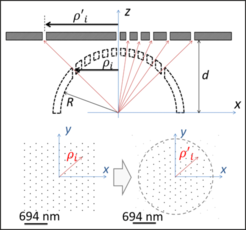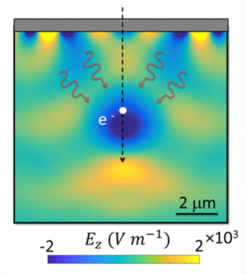Photon sieve opens up road to combine electron and optical spectroscopy
Research is aiming at probing matter at a micro- or nano-scale. Different methods are suitable for this task, for example x-rays probe the structure of matter, light probes the dielectric and electronic properties such as reflection or transmission, and electrons can even visualize the individual atoms of matter in a transmission electron microscope. Also, the energy loss of electrons upon transmission through a sample can be analyzed and reveals details about the electronic structure of the material.
Commonly, one method at a time is employed. Namely, if one is interested in a phase transition between a metal and an insulator, optical measurements using light in reflectance can tell whether the material has some kind of metallic gloss or is rather dielectric and hence transparent. Looking at the same material with electrons, however, using a transmission electron microscope (TEM), would reveal that such a metal-to-insulator phase transition undergoes a change in its atomic structure. For example, the lattice could change from a rutile structure to a monoclinic structure, which is visible in TEM images or in X-ray crystallography.
In order to study the dynamics of this process, which is taking place on a femtosecond timescale, so-called pump-probe spectroscopy can be employed. In such an experiment, a first ultrashort laser pulse would hit a sample and deposit some heat into it, causing a metal-to-insulator phase transition to occur, and a second laser pulse a few femtoseconds later would hit it again to probe its optical properties. When changing the delay between pump and probe pulses, one can infer the dynamics of the phase transition in that particular material.
It would be particularly elegant if several methods could be combined to carry out these studies simultaneously. For example, exciting the sample with an ultrashort laser pulse and probing it afterwards with ultrashort X-ray pulses or ultrashort electron pulses would directly reveal the structural information and its dynamics. However, such experiments require up to now gigantic efforts, such as the femtosecond free-electron laser at DESY in Hamburg at the cost of more than 1 billion EUR. Alternative methods such as combinations of femtosecond lasers and ultrashort TEM setups are extremely rare and require still equipment at the cost of several million EUR.
Now, working at the Max-Planck-Institute for Solid State Research in Stuttgart, junior group leader Dr. Nahid Talebi has come up with a brilliant solution that could make such studies much simpler. In collaboration with the AMOLF Institute in Amsterdam and the 4th Physics Institute in Stuttgart she created the first electron-driven photon source, which can give simultaneously an ultrashort electron pulse of a few femtoseconds together with a light pulse of also just a few femtoseconds. In her elegant design, which consists of a novel „photon sieve“ created by Dr. Mario Hentschel at University of Stuttgart (see Fig. 1), the light and electron pulses are synchronized to each other even on an attosecond time scale.
The key element in her invention, the photon sieve, consists of a 25 nm thick silicon nitride membrane with 50 nm of gold on top. In this gold layer, a regular pattern of nanoholes is carefully drilled using gold ions from a brandnew and newly developed ion beam lithography machine that was recently installed by the company Raith from Dortmund, Germany. Nahid Talebi, who originally comes from Iran, meticulously calculated the positions of the individual holes in the gold layer by using the concept of transformation optics (see Fig. 2). This concept was recently invented by famous British scientist Sir John Pendry to create optical cloaks and perfect lenses.


The photon sieve is hit by a single electron, which creates an oscillation of the electron gas in the gold, called a surface plasmon. This surface plasmon propagates along the gold layer and interacts with the holes. The surface plasmons then lose their energy (measured by PhD student Surong Guo at the Stuttgart Center for Electron Microscopy) and emit elementary waves at the holes, which interfere according to the law that was found by Dutch physicist Christian Huygens already in 1678. This interference of the individual light waves leads to a sharp common focus a few micrometers behind the photon sieve (see Fig. 3). An angle-resolved cathodoluminescence setup installed in Albert Polman´s group at AMOLF was used, by the French post doc Sophie Meuret, to detect the generated light at the far-field of the structure (see Fig. 4).

Fig. 4: Angle-resolved catholominescence (CL) map taken at AMOLF in Amsterdam below the photon sieve.

Fig. 3: The engineered planar electron-driven photon sieve can be used to focus the radiation at a few micrometers below the structure.

The original electron can pass through the extremely thin membrane and can then hit a sample. Afterwards, it can be utilized to either image the structure of this sample or to measure its energy loss. The re-emitted light from the photon sieve has a fixed delay with respect to that electron pulse and can hit the sample right after the electron, thus probing its optical properties. Conveniently, the delay between electron and light pulse can be changed and even set to negative delay times, meaning that the light hits the material first and changes its electronic properties and the electron probes the structural properties later (see Fig. 5).
Talebi, who recently obtained the highly competitive and prestigious ERC starting grant of the European Research Council, published these findings in the journal Nature Communications.
In the future, she wants to utilize the phase coherence between the electron and photon pulses to realize time-energy holography, where she would use the interference between electron-induced and light-induced excitations to reveal the deep microscopic secrets of excitations in matter.















